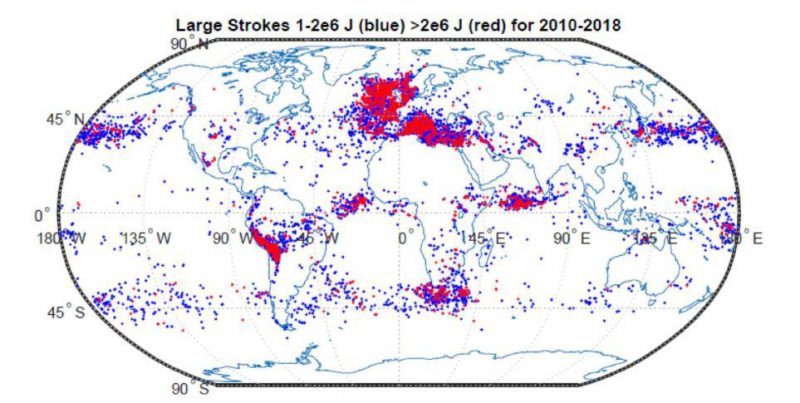10 September 2019
Lightning ‘superbolts’ form over oceans from November to February
Posted by larryohanlon
By Hannah Hickey
The lightning season in the Southeastern U.S. is almost finished for this year, but the peak season for the most powerful strokes of lightning won’t begin until November, according to a newly published global survey of these rare events.
The new study maps the location and timing of “superbolts” — bolts that release electrical energy of more than 1 million Joules, or a thousand times more energy than the average lightning bolt, in the very low frequency range in which lightning is most active. Results show that superbolts tend to hit the Earth in a fundamentally different pattern from regular lightning, for reasons that are not yet fully understood.
The study was published Sept. 9 in the Journal of Geophysical Research: Atmospheres, a journal of the American Geophysical Union.

This map shows the frequency of lightning strikes of all sizes measured by the World Wide Lightning Location Network, with pink being the highest values. Lightning occurs most often over land, with a few so-called “lightning chimneys” that include the Southeastern U.S. and the islands of Southeast Asia. Credit: World Wide Lightning Location Network
“It’s very unexpected and unusual where and when the very big strokes occur,” said lead author Robert Holzworth, a University of Washington (UW) professor of Earth and space sciences who has been tracking lightning for almost two decades.
Holzworth manages the World Wide Lightning Location Network, a UW-managed research consortium that operates about 100 lightning detection stations around the world, from Antarctica to northern Finland. By seeing precisely when lightning reaches three or more different stations, the network can compare the readings to determine a lightning bolt’s size and location.
The network has operated since the early 2000s. For the new study, the researchers looked at 2 billion lightning strokes recorded between 2010 and 2018. Some 8,000 events — four millionths of a percent, or one in 250,000 strokes — were confirmed superbolts.
“Until the last couple of years, we didn’t have enough data to do this kind of study,” Holzworth said.

The dots represent superbolts, lightning with an energy of at least 1 million Joules. Red dots are particularly large superbolts, with an energy of more than 2 million Joules. Superbolts are most common in the northeast Atlantic and the Mediterranean Sea, with smaller concentrations in the Andes, off the coast of Japan, and near South Africa. Credit: Holzworth et al./Journal of Geophysical Research: Atmospheres
The authors compared their network’s data against lightning observations from the Maryland-based company Earth Networks and from the New Zealand MetService.
The new paper shows that superbolts are most common in the Mediterranean Sea, the northeast Atlantic and over the Andes, with lesser hotspots east of Japan, in the tropical oceans and off the tip of South Africa. Unlike regular lightning, the superbolts tend to strike over water.
“Ninety percent of lightning strikes occur over land,” Holzworth said. “But superbolts happen mostly over the water going right up to the coast. In fact, in the northeast Atlantic Ocean you can see Spain and England’s coasts nicely outlined in the maps of superbolt distribution.”
“The average stroke energy over water is greater than the average stroke energy over land — we knew that,” Holzworth said. “But that’s for the typical energy levels. We were not expecting this dramatic difference.”

Robert Holzworth stands with a test lightning sensor on the roof of a UW building. The pipe contains an antenna that detects the electrical frequencies generated by lightning. Seattle’s actual detector is on the roof of a neighboring building. Credit: Dennis Wise/University of Washington
The time of year for superbolts also doesn’t follow the rules for typical lightning. Regular lightning hits in the summertime — the three major so-called “lightning chimneys” for regular bolts coincide with summer thunderstorms over the Americas, sub-Saharan Africa and Southeast Asia. But superbolts, which are more common in the Northern Hemisphere, strike both hemispheres between the months of November and February.
The reason for the pattern is still mysterious. Some years have many more superbolts than others: late 2013 was an all-time high, and late 2014 was the next highest, with other years having far fewer events.
“We think it could be related to sunspots or cosmic rays, but we’re leaving that as stimulation for future research,” Holzworth said. “For now, we are showing that this previously unknown pattern exists.”
Co-authors of the new study are Michael McCarthy, Abram Jacobson, James Brundell and Craig Rodger.
Hannah Hickey is a science writer for the University of Washington News.


 GeoSpace is a blog on Earth and space science, managed by AGU’s Public Information staff. The blog features posts by AGU writers and guest contributors on all sorts of relevant science topics, but with a focus on new research and geo and space sciences-related stories that are currently in the news.
GeoSpace is a blog on Earth and space science, managed by AGU’s Public Information staff. The blog features posts by AGU writers and guest contributors on all sorts of relevant science topics, but with a focus on new research and geo and space sciences-related stories that are currently in the news.